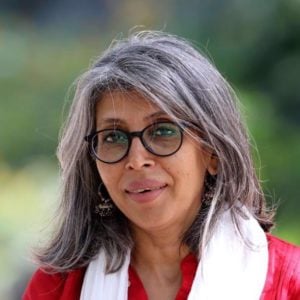Following devastating floods that destroyed crops in the breadbasket region of India and Pakistan, food insecurity continues to loom large.
Sitting in his now ruined fields, Gurpreet Singh recalls how his five-year-old daughter searched for cheap toys at a Diwali fair in October, knowing her father could not afford much this festival season. “When I tried to buy her a toy from the festival fair, she refused. She knew there were difficult times ahead,” he says.
The child has faced circumstances far beyond anyone her age should have. The floods that wreaked havoc on the Punjab region in India and Pakistan in August submerged her family’s farm for over a month, destroying an entire season’s worth of crops and killing some of their livestock. Her only cow was not spared.
Singh is the elected head of four villages in the Kapurthala district of Punjab state in India. He lost the rice crop on his 2.6-hectare farm in the district’s Sultanpur Lodhi tehsil (local administrative division), which fed his family of eight.
Several hundred kilometres away, in the neighbouring Punjab province in Pakistan, 58-year-old Tariq Mahmood recalls how the floodwaters submerged his farmland, rice and sugarcane crops just as they were ready for harvesting. “We could only save 30% of our sugarcane” after returning to the village, he says.
Mahmood’s land is just 500 metres from the Sutlej River in the city of Chishtian, Bahawalnagar district, south-east Punjab. His 10-hectare farm, which he shares with his three brothers, will take at least six months to restore to a cultivable state, he says.
Punjab, the breadbasket for both India and Pakistan, has experienced several climate shocks in the last few years, including heatwaves and floods. But for India, the devastation this year has been reported as the worst since the severe 1988 floods.
This time, an estimated 175,000 hectares of agricultural land was washed away in India alone across all 23 districts in Punjab state, with at least 57 people dead.
In Pakistan’s Punjab, at least 304 people have died from the rains and floods, according to the country’s National Disaster Management Authority. The UN’s Food and Agriculture Organization (FAO) notes that in the province, 1.12 million hectares of agricultural land were affected, or 9% of Punjab’s total agricultural land. Over 214,000 hectares of rice and 122,000 hectares of cotton were inundated, James Robert Okoth, officer-in-charge of the FAO in the country, told Dialogue Earth.
Now, as the region begins the process of rebuilding, farmers in Punjab lament the inadequate support given by their governments for recovery, leading to fears of food shortages in both countries.
What caused the severe flooding?
In India’s Punjab, the floods this year were caused by torrential rains and the rainwater being suddenly released from dams as a surge. “For days, we saw the waters in the canals swell, but the government did not do anything,” says Gurpreet Singh. Then one day in mid-August, “we woke up to waterlogged farms”, he notes.
In Pakistan, intense monsoon rains, exacerbated by impacts of climate change, swelled the Sutlej, Chenab and Ravi rivers in Punjab. This was compounded by India releasing water from its upstream dams, which it had informed Pakistan about. The combination of factors led to widespread destruction in a province where agricultural labour is a key source of income for rural households.
According to Pakistan’s latest Agriculture Census, published in August, Punjab province provides between 51-68% of wheat, rice, maize, cotton and sugarcane grown in the country, as well as 85% of fodder. The trade body Pakistan Business Forum told Arab News in September that its preliminary assessment of the damage in Punjab estimated crop losses of 60% of rice, 30% of sugarcane and 35% of cotton.
India’s Punjab, meanwhile, grows 15% of the country’s wheat and nearly 10% of its rice. Punjab accounted for over 40% of the country’s basmati rice exports, the Indian Rice Exporter’s Federation told UK-newspaper the Independent. The floods led to 20-25% losses in the rice variety, reported science journal Nature.
In Pakistan, food experts who spoke to Dialogue Earth say the floods’ impacts will increase small landholders’ reliance on credit as well as deepen debt cycles. The floods have meant reduced income and severe fodder shortages, says Okoth. “Many are resorting to distress sales of livestock.”
In October, inflation in the country rose from 5.6% to 6.24%, reported Dawn, with 23% and 16% increases in the price of wheat and wheat flour respectively. The Ministry of Finance’s Economic Outlook for that month said inflation remained “affected by food-supply pressures” due to flood-related disruptions.
Post-disaster recovery
Recovery in the Punjab region has been a struggle for those who relied on farming for their income.
Normally, the summer harvest funds winter sowing. This year, however, that cycle collapsed with the floods destroying the harvest, leaving farmers with no liquidity to invest in the next season. “Even those with modest landholding like us will be forced to take loans,” says Mahmood.
In late September, the Pakistani government announced that farmers who suffered losses would receive compensation of around PKR 49,500 (USD 175) per hectare. But this “barely scratches the surface of the real cost of making land cultivable again”, says Mian M. Umair Masood, who represents Kissan Ittehad, a farmers’ association in Pakistan.
He explains that affected farmers must first clear the debris using machinery such as heavy-duty tractors, at a cost of PKR 20,000-25,000 (USD 71-88) per hectare. Subsequently, they have to buy fresh wheat seed, since most stored stocks of the seed were washed away in the floods. This costs another PKR 12,000-20,000 (USD 42-71) per hectare. “These restoration costs nearly consume the entire relief amount, leaving farmers with little to spend on irrigation water, fertilisers, herbicides – all of which will now be required in greater quantities, at inflationary rates,” Masood adds.
Meanwhile, the Indian government has announced INR 49,400 (USD 553) per hectare in compensation, which Gurpreet Singh says is far too low to break even. This means he would receive USD 1,386 from the government. Singh was expecting to earn at least INR 2,390 (USD 27) per 100 kilograms of rice. Since each hectare of land produces at least 8,650 kgs, his total earnings would have been around INR 538,000 (USD 6,000) for the season.
He adds that farmers have no cash left to buy and clean seeds for impurities that impact yield, or hire workers to sow seeds for the next season.
The crop losses may lead to food shortages in India as farmers now suffer from the post-flood challenges of silting and land erosion, wrote Indra Shekhar Singh, an independent agri-policy analyst and former director of policy and outreach at the National Seed Association of India.
In the aftermath of the floods, Okoth says the FAO recommends immediate cash transfers for farmers, as well as provision of seed, livestock feed and fertiliser “to safeguard the Rabi [winter agricultural] season”.
Both Punjabs unprepared for disaster
Experts and local community leaders stress that before focusing on compensation or climate mitigation, the region’s governments should focus on disaster preparedness and climate adaptation, which they say is lacking.
“There have been floods every two years, but despite that, there is no readiness. Climate adaptation, despite huge losses [incurred], is still poor due to misgovernance,” says Devinder Sharma, an Indian food and trade policy analyst.
In India, he says there should be an inquiry into the timing of the release of water from the country’s dams, “and the fact that only 1,600 crore rupees [INR 1.6 billion, or USD 178 million] has been released for the billions of dollars’ worth of losses [faced by flood-affected families]” in the state.
In Pakistan’s Punjab, Nighat Dad, a lawyer from the town of Ratta Matta in Jhang district, says the Chenab River has widened so much as a result of the recent floods that entire villages are now being forced to relocate.
Dad, who also runs the non-profit Digital Rights Foundation, says the Pakistani government took weeks to reach many affected communities, with private citizens and local organisations stepping up first.
She assembled a team of volunteers leading relief efforts in their area that worked to provide rations, as well as raise funds to rebuild homes and help farmers prepare for the next agricultural season in Jhang and neighbouring Chiniot district. Dad says such endeavours filled the gap between the state’s response and private charity that should never have existed in the first place. “The government’s response was reactive [rather] than preventive,” she adds.
Looking to the future, Okoth says that for longer-term resilience, the Pakistani government should invest in disaster-risk financing mechanisms to protect farmers from future shocks. It should also strengthen early-warning systems and geospatial monitoring for preparedness, as well as ensure there is subsidised support for farmers to buy next year’s inputs for the monsoon planting season, such as seeds, fertiliser and machinery.
Sharma says the governments must document the impacts faced by disaster-hit regions and share that data with experts and farmers.
They should also begin treating such calamities as national disasters rather than isolated events, he adds. Categorising these events as disasters “will help the governments to ensure a proactive and long-term approach to disaster management, rather than a reactive and post-event response”, says Sharma.






















